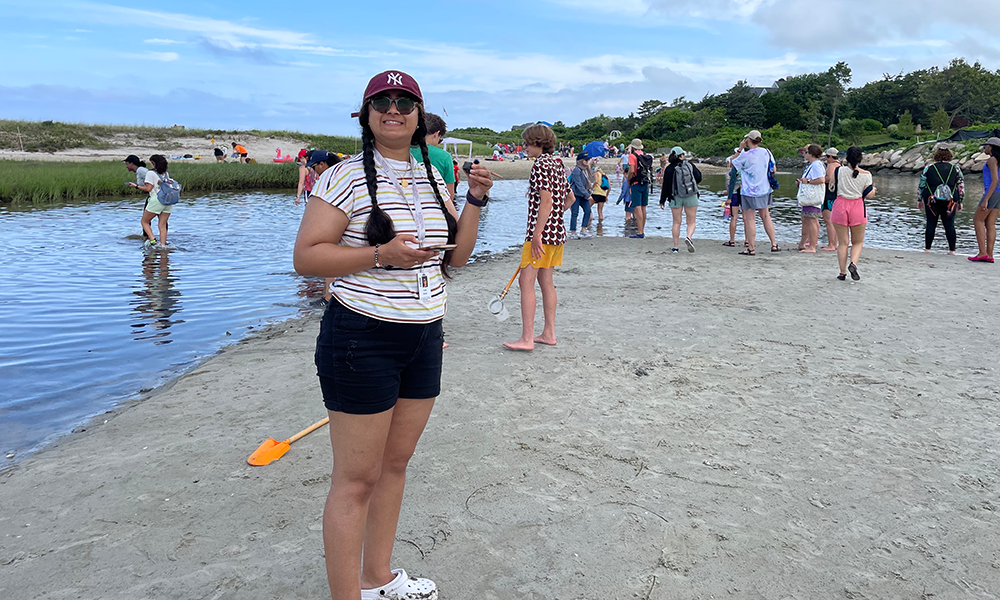Studying microbes in marine environments and microcapsules
Lauren Smith
Sep 25, 2023

Source: Huda Usman
Huda Usman spent her summer in the salt marshes, leveling up her understanding of microorganisms and their role in chemical transformations.
Usman, a Ph.D. student in chemical engineering, traveled to Woods Hole, Massachusetts, for a microbial diversity course at the prestigious Marine Biological Laboratory (MBL).
As part of its mission, the MBL convenes leading early-career scientists, Nobel Laureates, and students from around the world. This summer's Microbial Diversity cohort of 20 students was a mix of postdocs, advanced Ph.D. students, and an assistant professor. They came from five continents. Usman received the Lola Ellis Robertson Endowed Scholarship from the MBL, along with NSF DMR funding from her advisor, Tagbo Niepa.
The course covered cultivation and physiology of bacteria, archaea, and microbial eukaryotes. "We did a lot of genomics, symbiosis, population genetics, and community analysis from the environmental samples we collected," adds Usman. She also learned molecular biology techniques.
Over the six-and-a-half-week course, Usman did almost 500 hours of lab and field work, in addition to time in lectures, seminars, and symposia. "The goal was to learn how to take environmental samples, and then grow different types of bacteria in the lab using selective enrichment techniques," she says.

Source: Huda Usman
Huda Usman and a classmate collecting marine samples from Trunk River.
One of Usman's favorite field work experiences was conducting the Volta experiment in a cedar swamp at night. "When you stomp in the swamp," she says, "you see bubbles." The bubbles are methane byproduct from methanogen bacteria. "We collected them in a funnel, covered it, and then put a lighter over it. When you take your hand off, it just fires up," Usman says.
In another project, Usman dissected an oyster to obtain spirochaetes from the gut, then enriched it in media.
For the last two and a half weeks of the course, students proposed, conducted, and presented a mini research project. Usman had been fascinated by the actinos she enriched earlier in the course. They changed color in the agar plates because they were secreting something. For her project, she wanted to investigate if the actinos were producing any antibiotics or natural products.
In a density-dependent experiment, Usman noticed that the bacteria closer to the other colony were producing something yellow. "I was interested in whether their neighbors matter," she says. "I wanted to know what was being produced: is this pigment an antibiotic, or is it just a pigment, and they don't care about their neighbors?"
Usman applied her new skills in bioinformatics. She assembled and annotated the genome sequence, using software tools to predict the biosynthetic gene clusters. "I found a quorum sensing molecule in the yellow substance, which activates antibiotic production. I found an antibiotic called Poly-L-lysine within one species of bacteria," she says.
Now that Usman knows how to grow streptomyces, a genus of actinobacteria, and how to identify the products they secrete, she can put them in the microcapsules she uses in her doctoral research. The technique will allow for faster screening. "I might see one capsule is turning brown, one capsule is turning yellow, so I can isolate those and study them separately," says Usman. She is also curious if the byproducts will diffuse out of the microcapsules.
The Niepa μBiointerface Lab is trying to design a high-throughput platform to miniaturize the culture system. "Instead of 25 mL cultures, we are using a nano-Liter culture system," says Usman. Approximately 95% of the bacteria in our environment are not culturable in the current system of plates and flasks. Cultivation conditions in the lab are too different from real life. A miniaturized culture device could be kept in the soil or in biological samples, for example, instead of in a lab environment.
Usman's lab work in the Microbial Diversity course was limited to environmental marine samples; in the Niepa μBiointerface Lab, she can work with pathogens. Further into her research, Usman would like to do community analysis, putting two species together to see if they produce something that affects the growth of the other. Her experience at the MBL has opened new avenues to explore the untapped potential of "microbial dark matter" and its beneficial effects on human health and performance.
